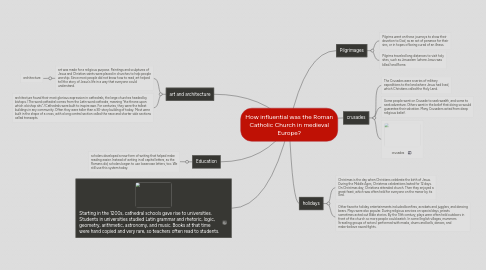How influential was the Roman Catholic Church in medieval Europe?
por samara wilson


1. Starting in the 1200s, cathedral schools gave rise to universities. Students in universities studied Latin grammar and rhetoric, logic, geometry, arithmetic, astronomy, and music. Books at that time were hand copied and very rare, so teachers often read to students.
2. Education
2.1. scholars developed a new form of writing that helped make reading easier. Instead of writing in all capital letters, as the Romans did, scholars began to use lowercase letters, too. We still use this system today.
3. art and architecture
3.1. art was made for a religious purpose. Paintings and sculptures of Jesus and Christian saints were placed in churches to help people worship. Since most people did not know how to read, art helped tell the story of Jesus’s life in a way that everyone could understand.
3.1.1. architecture
